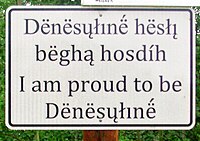Dotless I
| Dotless I | |
|---|---|
| I ı | |
| Usage | |
| Writing system | Latin script |
| Type | alphabetic |
| Language of origin | Turkish language |
| Phonetic usage | [ɯ] [ɪ] |
| Unicode codepoint | U+0049, U+0131 |
| History | |
| Development | I i
|
| Time period | 1928 to present |
| Sisters | İ i |
| Other | |
| Writing direction | Left-to-Right |
I, or ı, called dotless i, is a letter used in the Latin-script alphabets of Azerbaijani, Crimean Tatar, Gagauz, Kazakh, Tatar, Karakalpak and Turkish. It commonly represents the close back unrounded vowel /ɯ/, except in Kazakh where it represents the near-close front unrounded vowel /ɪ/. All of the languages it is used in also use its dotted counterpart İ while not using the basic Latin letter I.
In scholarly writing on Turkic languages, ï is sometimes used for /ɯ/.[1]
Implications for ligature use

This section possibly contains original research. (September 2021) |
In some fonts, if the lowercase letters fi are placed adjacently, the dot-like upper end of the f would fall inconveniently close to the dot of the i, and therefore a ligature glyph is provided,[2] usually with the top of the f extended to serve as the dot of the i. A similar ligature for ffi is also possible. Since the forms without ligatures are sometimes considered unattractive and the ligatures make the i dotless, such fonts are not appropriate for use in a Turkish setting. However, the fi ligatures of some fonts do not merge the letters and instead space them next to each other, with the dot on the i remaining. Such fonts are appropriate for Turkish, but the writer must be careful to be consistent in the use of ligatures.
In computing
| Preview | I | ı | ||
|---|---|---|---|---|
| Unicode name | LATIN CAPITAL LETTER I | LATIN SMALL LETTER DOTLESS I | ||
| Encodings | decimal | hex | dec | hex |
| Unicode | 73 | U+0049 | 305 | U+0131 |
| UTF-8 | 73 | 49 | 196 177 | C4 B1 |
| Numeric character reference | I |
I |
ı |
ı |
| Named character reference | ı, ı | |||
| ISO 8859-9 | 73 | 49 | 253 | FD |
| ISO 8859-3 | 73 | 49 | 185 | B9 |
Usage in other languages

The dotless ı may also be used as a stylistic variant of the dotted i, without there being any meaningful difference between them.
This is common in older Irish orthography, for example, but is simply the omission of the tittle rather than a separate letter. The í is a separate letter as is ì in Scottish Gaelic. Though historically Irish only used an "i" without a dot, so as to not confuse with "í", this dotless "ı" should not be used for Irish. Instead a font with "i" in the normal location should be used that has no dot. See other old style Irish letters and the symbol for & still used in modern Irish text and Irish orthography.
In some of the Athabaskan languages of the Northwest Territories in Canada, specifically Slavey, Dogrib and Chipewyan, all instances of i are undotted to avoid confusion with tone-marked vowels í or ì.
Lowercase dotless ı is used as the lowercase form of the letter Í in the official Karakalpak alphabet approved in 2016.
Both the dotted and dotless I can be used in transcriptions of Rusyn to allow distinguishing between the letters Ы and И, which would otherwise be both transcribed as "y", despite representing different phonemes. Under such transcription the dotted İ would represent the Cyrillic І, and the dotless I would represent either Ы or И, with the other being represented by "Y".
See also
- İ, the letter's dotted counterpart
- Tittle: the dot above "i" and "j" in most of the Latin scripts
- Yery (ы), a letter used to represent [ɯ] in Turkic languages with Cyrillic script, and the similar [ɨ] in Russian
- I with bowl, a letter that represented [ɯ] in the Latin-based Yañalif alphabet used for the Turkic languages of the former Soviet Union prior to those languages' adoption of Cyrillic
References
- ^ Erdal, Marcel (2004). A Grammar of Old Turkic. Boston: Brill. p. 52. ISBN 9004102949.
- ^ Bear, Jacci Howard (2019-10-16). "Basics of Ligature in Typography and Publishing". ThoughtCo. Archived from the original on 2023-05-26. Retrieved 2023-06-27.
External links
- Unicode chart
- Tex Texin, Internationalization for Turkish: Dotted and Dotless Letter "I", accessed 15 Nov 2005
